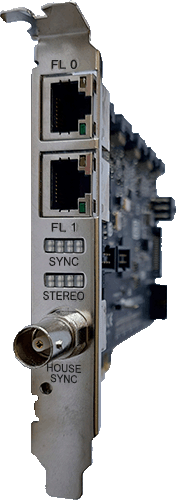Loading...
The NVIDIA sync card is part of the discontinued OCTO Server. For other Server hardware it is an optional accessory board. The sync card has mainly two purposes:
Mosaic is NVIDIA's software technology that abstracts multiple physical displays into a larger virtual display. When the virtual display spans across multiple graphics cards, the sync board is needed to synchronize them. In other words, When working with multi-GPU Mosaic, the sync card automatically keeps all included displays synchronized.
This is of special interest for OCTO Servers as they are equipped with two graphics cards which need to be combined for the Pandoras Box render engine.
Frame lock synchronizes multiple displays (in one or multiple systems) to a timing leader. Frame Lock can be used with individual physical displays and single or multi-GPU Mosaic displays.
You can sync a display to an external timing generator, the gen lock. The selected display can be an individual physical display or Mosaic display and can be used as the frame lock leader if desired.
Please note that at start-up all LEDs turn on and stay on until the grahics driver loads. Once the driver is loaded, the LEDs start to show the status of the card.  FL 0, FL 1 (RJ-45) + LEDsBoth Frame Lock connectors act either as input or output ports for the Frame Lock signal. Connect them to ports of another Sync card using CAT-5 ethernet cables. An example is depicted in the topic "Setting up Frame Lock". Depending on those settings, the connectors auto-configure: the timing server sends two outputs whilst connected nodes configure themselves to one output and one input. The upper amber LEDs (=output) indicates that a port is sending the Frame Lock signal whilst the lower green LED (=input) indicates that the port is receiving it. Important: Do not use Ethernet hubs or switches to branch or extend the signal. The card is not compactible with TCP/IP protocols and will not operate if it is connected to networking equipment! 4x Sync LEDs, 4x Stereo LEDsThere are four "Frame Lock Sync Status" LEDs and four "Stereo Phase Status" LEDs which provide information on the current state of synchronization of the card. "Stereo" refers to the stereoscopic settings in the NVIDIA Control Panel. - Sync LED Status
- Stereo LED Status
House Sync (BNC) + LEDThe House Sync connector can either be configured to output a timing signal or to receive one from an external sync generator. Three types of external timing sources are supported: - TTL: 3.3 V, 50% duty cycle, high impedance - Bi-Level Composite (NTSC/PAL): 75Ω impedance - Tri-Level Composite (HDTV): 75Ω impedance (SMPTE Standard 240 compliant) Using timing signals Voltages above specification, i.e. +3.3V for TTL or ±300mV for Composite will damage the card! When a valid signal is connected the LED below the BNC connector lights solid green. Once the card is using the external signal the LED flashes green at the rate of the incoming sync signal. If the BNC port is configured as a Sync output, don not connect to a Sync generator. This may cause damage to either one of the devices. At the end of the chapter "Setting up Frame Lock" you may find the pargraph about "External Timings" which explains the [timing] "Server Settings" dialog in the NVIDIA Control Panel with the options to enable the BNC output or to use the external house sync signal respectively. |
The card drivers are preinstalled on your Server hardware. The sync card does not require a dedicated driver; all the files needed to operate it are included in the driver for the graphics card. As mentioned in the graphics card chapter, the graphics card driver on your Christie hardware product is tested and certified by us for best video rendering and playback performance. Even if the installed driver might not be the newest one available from the NVIDIA website it is NOT recommended to update this driver to their latest one. All drivers can be found locally under C:\system and in the Download-Center where you can also check for updates.
Please open the NVIDIA Control Panel to setup the card. The topic "Setting up Frame Lock" in the graphics cards chapter describes those options in full detail. In short: The "System Topologie" tab provides a good overview about the current state, e.g. whether an external frame lock signal is being received. The "Synchronise Displays" tab allows you to setup the feature, that is choosing the timing leader and clients. Note that in contrast to other input and output boards, the sync card is not depicted in the Windows Device Manager.